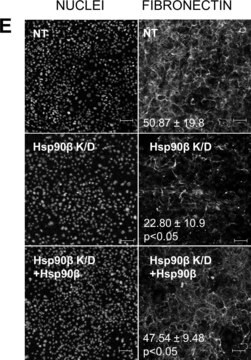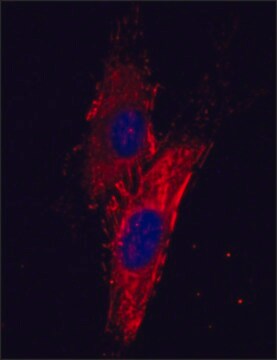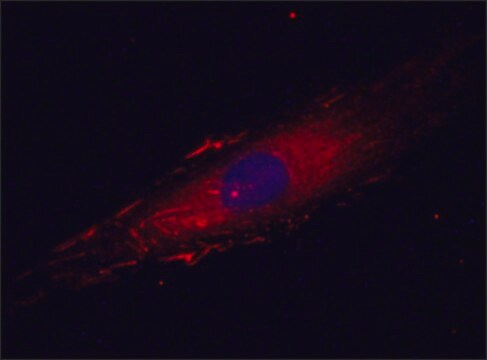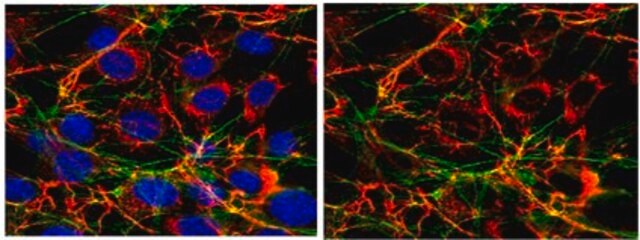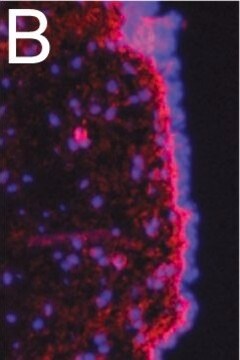おすすめの製品
由来生物
mouse
品質水準
抗体製品の状態
culture supernatant
抗体製品タイプ
primary antibodies
クローン
FN-3E2, monoclonal
フォーム
buffered aqueous solution
分子量
~220-260 kDa
交差性
chicken, rat, human, mouse
テクニック
immunoblotting: suitable
immunofluorescence: 1:2,000-1:4,000 using human foreskin fibroblast Hs68 cells
immunohistochemistry: suitable
アイソタイプ
IgM
UniProtアクセッション番号
輸送温度
dry ice
保管温度
−20°C
ターゲットの翻訳後修飾
unmodified
遺伝子情報
human ... FN1(2335)
詳細
Anti-Cellular Fibronectin antibody, Mouse monoclonal (mouse IgM isotype) is derived from the FN-3E2 hybridoma produced by the fusion of mouse myeloma cells and splenocytes from mice immunized with the antigens released in culture from a breast cancer cell line. Fibronectin (FN), also known as cold-insoluble globulin (CIG), is an extracellular matrix multi-domain glycoprotein composed of two nearly identical disulphide bound polypeptides. Fibronectin 1 is a glycoprotein, that is coded by FN1 gene. It is expressed in the plasma and at the cell surface. It is mapped to human chromosome 2q35. Cellular fibronectin is produced by various cell types, including fibroblasts, endothelial cells, chondrocytes, synovial cells, and myocytes.
免疫原
Antigens released in culture from a breast cancer cell line
アプリケーション
Anti-Cellular Fibronectin antibody, Mouse monoclonal has been used in:
- immunoblotting
- immunofluorescence
- immunohistochemistry
Anti-cellular Fibronectin antibody, mouse monocloneal has been used in various immunochemical techniques including immunoblotting (220-260 kDa), immunofluorescence, and immunohistochemistry.
生物化学的/生理学的作用
Fibronectin participates in cell adhesion, growth, migration, wound healing, blood coagulation and metastasis. Mutations in FN1 results in glomerulopathy. It plays an important role in cell attachment and spreading, control of cell cytoskeleton, morphology and differentiation. FN1 is also involved in extracellular matrix formation, haemostasis and thrombosis. It is a ubiquitous and essential component of the extracellular matrix (ECM) and plays a vital role in tissue repair mechanism.
物理的形状
The product is supplied as a culture supernatant solution containing 15 mM sodium azide as a preservative. The product contains fetal calf serum.
その他情報
This product is for R&D use only, not for drug, household, or other uses.
適切な製品が見つかりませんか。
製品選択ツール.をお試しください
保管分類コード
10 - Combustible liquids
WGK
WGK 3
引火点(°F)
Not applicable
引火点(℃)
Not applicable
適用法令
試験研究用途を考慮した関連法令を主に挙げております。化学物質以外については、一部の情報のみ提供しています。 製品を安全かつ合法的に使用することは、使用者の義務です。最新情報により修正される場合があります。WEBの反映には時間を要することがあるため、適宜SDSをご参照ください。
Jan Code
SAB4200784-BULK:
SAB4200784-100UL:
SAB4200784-VAR:
最新バージョンのいずれかを選択してください:
The extracellular matrix proteins laminin and fibronectin contain binding domains for human plasminogen and tissue plasminogen activator.
Moser TL, et al.
The Journal of Biological Chemistry, 268(25), 18917-18923 (1993)
Receptors for cold-insoluble globulin (plasma fibronectin) on human monocytes.
Bevilacqua MP, et al.
The Journal of Experimental Medicine, 153(1), 42-60 (1981)
E L George et al.
Development (Cambridge, England), 119(4), 1079-1091 (1993-12-01)
To examine the role of fibronectin in vivo, we have generated mice in which the fibronectin gene is inactivated. Heterozygotes have one half normal levels of plasma fibronectin, yet appear normal. When homozygous, the mutant allele causes early embryonic lethality
R Manabe et al.
The Journal of cell biology, 139(1), 295-307 (1997-10-06)
Fibronectin (FN) has a complex pattern of alternative splicing at the mRNA level. One of the alternatively spliced segments, EDA, is prominently expressed during biological processes involving substantial cell migration and proliferation, such as embryonic development, malignant transformation, and wound
Yong Mao et al.
Matrix biology : journal of the International Society for Matrix Biology, 24(6), 389-399 (2005-08-03)
The extracellular matrix provides a framework for cell adhesion, supports cell movement, and serves to compartmentalize tissues into functional units. Fibronectin is a core component of many extracellular matrices where it regulates a variety of cell activities through direct interactions
ライフサイエンス、有機合成、材料科学、クロマトグラフィー、分析など、あらゆる分野の研究に経験のあるメンバーがおります。.
製品に関するお問い合わせはこちら(テクニカルサービス)

